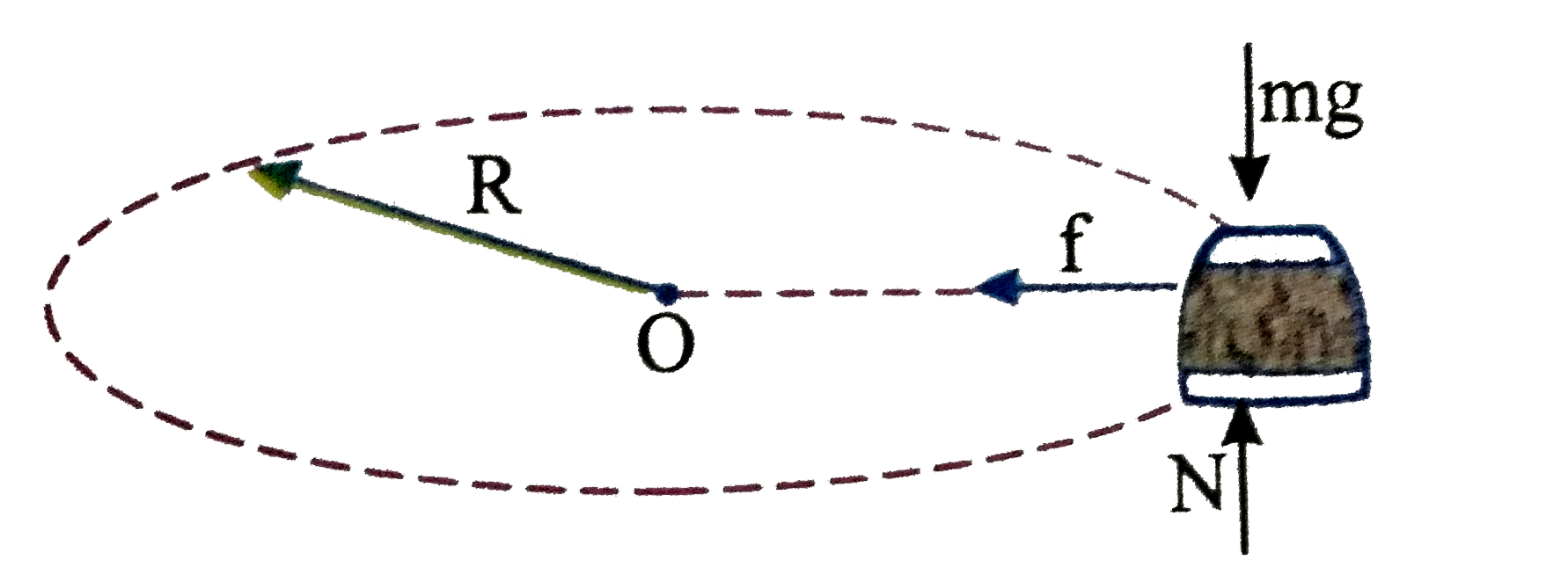The minimum velocity (in ms^(-1)) with which a car driver must traverse a flat curve of radius 150m and coefficient of friction 0.6 to avoid skidding is
60
30
15
25
The correct Answer is:B
The friction will provide required centripetal force
From F.B.D of car
f=mv2R…(i)
if the car does not skid the friction should be static in nature
⇒mv2R≤μmg⇒v≤√μRg
Maximum permitted velocity v=√μRg
∴v=√0.6×150×10=30m/s
 .
.
Topper's Solved these Questions
- NEWTONS LAWS OF MOTIONBook:NARAYNAChapter:NEWTONS LAWS OF MOTIONExercise:SINGLE ANSWER QUESTIONS
Explore 35 Videos
- NEWTONS LAWS OF MOTIONBook:NARAYNAChapter:NEWTONS LAWS OF MOTIONExercise:SINGLE ANSWER QUESTIONS Passage -1
Explore 1 Video
- NEWTONS LAWS OF MOTIONBook:NARAYNAChapter:NEWTONS LAWS OF MOTIONExercise:LEVEL -III
Explore 31 Videos
- MOTION IN A STRAIGHT LINEBook:NARAYNAChapter:MOTION IN A STRAIGHT LINEExercise:Level 2 H.W
Explore 29 Videos
- OSCILLATIONSBook:NARAYNAChapter:OSCILLATIONSExercise:EXERCISE - IV
Explore 41 Videos
Similar Questions
Find the maximum speed with which a car can turn on a bend without skidding, if radius of bend is 20 m and coefficient of friction between the road and the tyres is 0.4.
View SolutionThe maximum speed (in ms−1 ) with which a car driver can traverse on a horizontal unbanked curve of radius 80 m with coefficient of friction 0.5 without skidding is : (g = 10 m/s2)
View Solution
Knowledge Check
The maximum velocity (in ms−1) with which a car driver must traverse a flat curve of radius 150 m and coefficient of friction 0.6 to avoid skidding is
A60B30C15D25The maximum velocity (in m/s) with which a car driver must transverse a flat curve of radius 150 m and coefficient of friction 0.6 to avoid skidding is
A60B30C15D25the maximum velocity with which a driver a must drive his car on a flat curved road of radius of curvature 150 m and coefficient of friction 0.6 to avoid the skidding of his car is ( take g=10m/s2)
A60m/sB50 m/sC40 m/sD30 m/s
The maximum speed of a car which can be safely driven along a curve of radius 10 m , If the coefficient of friction between the tyres and the road is 0.5, is (g=9.8m/s2)
View SolutionFind the maximum velocity for skidding for a car moved on a circular track of radius 100 m . The coefficient of friction between the road and tyre is 0.2
View SolutionThe maximum speed with which a car driven round a curve of radius 18 m without skidding (where ,g=10ms−2 and the coefficient of friction between rubber tyres and the roadway is 0.2)is
View SolutionWhat is the maximum speed with which a car safely turn a around a curved horizontal road of radius 50 m ? [The coefficient of friction between the tyres and the surface of the road is 0.4 ]
View SolutionWhat is the maximum speed at which a car can turn round a curve of 30 m radius on a level road if the coefficient of friction between the types and the road is 0.4 .(Given, acceleration due to gravity =10ms−2
View Solution

